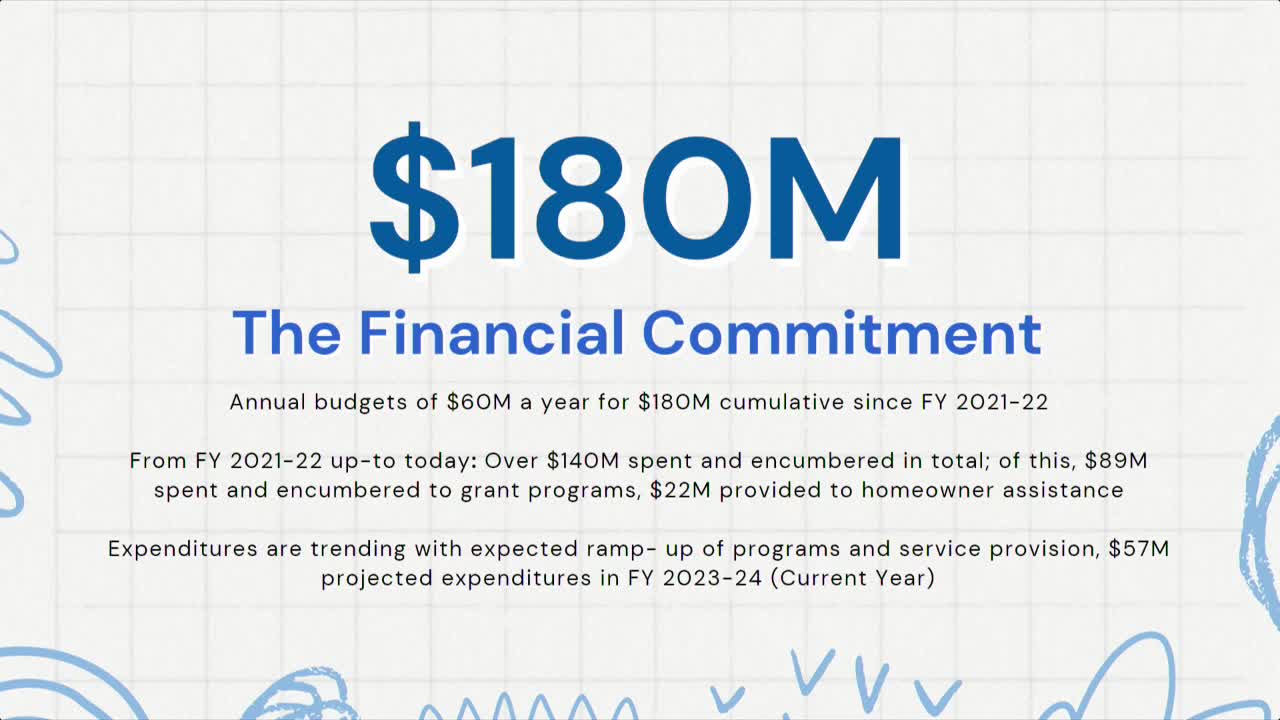San Francisco's Dreamkeeper initiative spends $57 million to boost housing for families
April 18, 2024 | San Francisco County, California

This article was created by AI summarizing key points discussed. AI makes mistakes, so for full details and context, please refer to the video of the full meeting. Please report any errors so we can fix them. Report an error »

In a recent government meeting, San Francisco County officials discussed significant investments aimed at addressing housing and economic disparities within the community. The meeting highlighted the ongoing efforts of the Dreamkeeper Initiative (DKI), which has been pivotal in providing support to marginalized residents, particularly Black families.
The financial commitment to the DKI has seen substantial growth over the past few fiscal years. In fiscal year 2022, the city allocated $15 million, which increased to $48 million in 2023. For the current fiscal year, expenditures are projected to reach $57 million, nearing the anticipated $60 million allocation. However, it was noted that the Human Rights Commission (HRC) represents only a fraction of these funds, which are distributed across various departments, including the Department of Public Health and the Office of Economic and Workforce Development.
Director Davis emphasized the importance of viewing these investments as a means to foster economic growth rather than mere handouts. He pointed out that the DKI not only aims to support Black residents but also seeks to uplift the entire city by investing in education and housing stability. The initiative has reportedly helped stabilize over 40 families and has been linked to long-term benefits such as increased personal income and improved community conditions.
Dan Adams, director of the Mayor's Office of Housing and Community Development, further elaborated on the successes of the DKI, noting that 80% of its beneficiaries are Black San Franciscans. He highlighted the down payment assistance loan program, which has enabled low to middle-income families to purchase homes, with 52 homes acquired since the program's inception. This initiative has also facilitated the return of families who had previously been priced out of the city.
The discussions underscored a broader commitment to economic justice and community investment, framing the DKI as a critical strategy for addressing systemic inequalities. As the city continues to implement these programs, officials remain focused on measuring their impact and ensuring that the benefits extend beyond immediate financial assistance to foster long-term community resilience and growth.
The financial commitment to the DKI has seen substantial growth over the past few fiscal years. In fiscal year 2022, the city allocated $15 million, which increased to $48 million in 2023. For the current fiscal year, expenditures are projected to reach $57 million, nearing the anticipated $60 million allocation. However, it was noted that the Human Rights Commission (HRC) represents only a fraction of these funds, which are distributed across various departments, including the Department of Public Health and the Office of Economic and Workforce Development.
Director Davis emphasized the importance of viewing these investments as a means to foster economic growth rather than mere handouts. He pointed out that the DKI not only aims to support Black residents but also seeks to uplift the entire city by investing in education and housing stability. The initiative has reportedly helped stabilize over 40 families and has been linked to long-term benefits such as increased personal income and improved community conditions.
Dan Adams, director of the Mayor's Office of Housing and Community Development, further elaborated on the successes of the DKI, noting that 80% of its beneficiaries are Black San Franciscans. He highlighted the down payment assistance loan program, which has enabled low to middle-income families to purchase homes, with 52 homes acquired since the program's inception. This initiative has also facilitated the return of families who had previously been priced out of the city.
The discussions underscored a broader commitment to economic justice and community investment, framing the DKI as a critical strategy for addressing systemic inequalities. As the city continues to implement these programs, officials remain focused on measuring their impact and ensuring that the benefits extend beyond immediate financial assistance to foster long-term community resilience and growth.
View full meeting
This article is based on a recent meeting—watch the full video and explore the complete transcript for deeper insights into the discussion.
View full meeting
